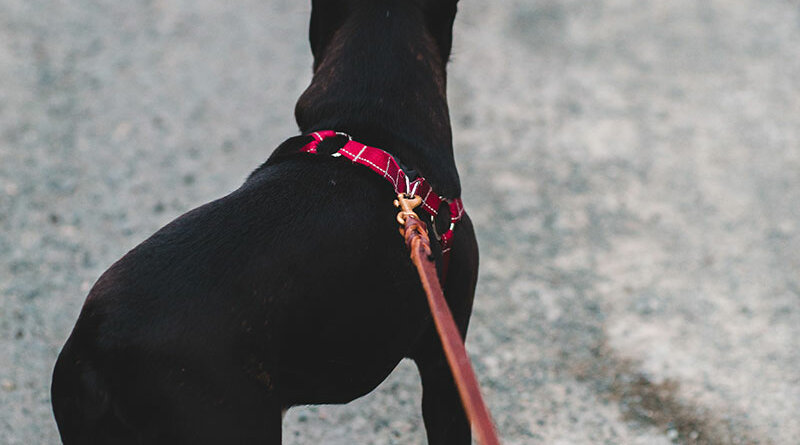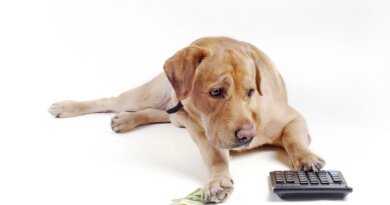Help! My Dog Pulls on the Leash
Dear Bark: My 55-pound dog pulls really hard on-leash, and it makes walking her a miserable experience—for me, because it’s so much work and (judging by her gasping and choking) presumably for her as well. I know she needs the exercise, and I’m filled with guilt, but I don’t like walking her. Am I doomed to living with an under-exercised dog and feeling terrible about it?
Your despair is shared by lots of people who want to walk their dogs but find the experience more akin to water skiing on pavement. The short answer to your question is that you are not doomed to continue in this way. You can enjoy walking your dog, and I am going to tell you how.
Invest in power steering. Changing the equipment you use to walk your dog can make a huge difference in your experience right away. The right kind of harness puts physics on your side so your dog can’t lean in with her full body weight to drag you along. The Freedom No-Pull Harness by 2 Hounds Design is a great option. Some find bungee leashes helpful because the leash has a bit of give, but for strong, relentless pullers, I prefer a plain six-foot nylon, rope or leather leash.
Use your movement to your advantage. If dogs are allowed to keep going forward, they learn that pulling is the way to get what they want, and they will keep doing it. Don’t ever allow your pulling dog to continue on her merry way. If she pulls, there are two options. One, stop immediately and don’t move until she lets up and there is slack in the leash. You may have to stop again three seconds later and do the same thing and that’s okay. Just be consistent about refusing to let her pull. Or two, when she pulls, turn and head in the other direction. That puts her behind you, at least momentarily, and she will not be pulling.
GET THE BARK IN YOUR INBOX!
Sign up for our newsletter and stay in the know.
Whether she’s pulling or not, be unpredictable. Making quick turns, reversing direction, speeding up and slowing down all make you more interesting, which means it’s more likely that your dog will follow you, going where you’re going rather than pulling you where she wants to go. True, some of your neighbors will find it amusing, but consider it just another good thing you’re doing for the community!
Exercise her before you walk. I know, I know, you’re probably thinking, “Isn’t the point of the walk to give her exercise?” Yes and no. Exercise is only one of the benefits of a dog walk. Dogs on walks also get to be in a new environment that can be more stimulating than being home. They are able to sniff and see other people and dogs. For now, the goal of the walk is to teach her to walk nicely so she can go on future walks rather than to supply all her exercise needs. If she’s tired when you start out, she’s more likely to behave as you want. That helps her to develop good habits and also allows you to reinforce her good behavior so that it become more likely in the future. Fetch or chases in the yard, or even going up and down the stairs multiple times can take the edge off her energy.
Train her to have good leash manners. While some dogs naturally walk calmly and politely all their lives with no specific instruction, that’s certainly not the norm. Most dogs need to learn how to do it. Bring top-quality treats on every walk and give her one whenever she is doing the right thing: walking without pulling you. The treats need to be really delicious—that usually means soft and smelly—to make an impact. Dry biscuits are not going to be good enough for most dogs.
Set your dog up for success. Make it as easy as possible for your dog to do the right thing so you can reinforce her with those delicious treats. In addition to exercising your dog ahead of time (you can tell it’s important because I’m mentioning it twice!), there are other steps you can take to set your dog up for success. Choose the time of day carefully and go when she tends to be the least excitable. Many dogs are extra jumpy and energetic mid-morning and late afternoon, but may be more manageable closer to the crack of dawn or later in the evening. Walk her on an out-and-back route rather than a circular one. Many dogs pull on the way out but are more contained on the return because they’ve already investigated the route’s sights and smells.
It will take a concerted effort and a commitment to consistency to shift your dog’s gears, but it will be worth it when you’re able to enjoy walking together and toss away the guilt.





Some truly marvelous work on behalf of the owner of this web site, perfectly great content material.
It is the best time to make some plans for the future and it is time to be happy. I have read this post and if I could I wish to suggest you few interesting things or tips. Maybe you could write next articles referring to this article. I want to read more things about it!
I really enjoy reading through on this internet site, it holds good articles. “We find comfort among those who agree with us–growth among those who don’t.” by Frank A. Clark.
Hi there very cool web site!! Man .. Excellent .. Superb .. I will bookmark your site and take the feeds also…I’m happy to find so many useful info here in the put up, we want develop more techniques in this regard, thank you for sharing. . . . . .
Some really nice and useful information on this website, likewise I conceive the layout contains fantastic features.
I am not sure where you are getting your info, but good topic. I must spend a while finding out more or understanding more. Thank you for fantastic info I used to be in search of this info for my mission.
It’s actually a great and helpful piece of info. I’m glad that you shared this useful info with us. Please keep us up to date like this. Thanks for sharing.